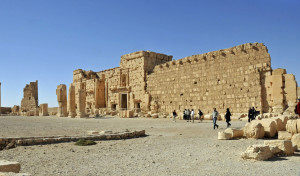About 150 miles northeast of Damascus are the partially reconstructed ruins of the ancient city of Palmyra. Those ruins include what has been described as the most important religious building in the Middle East during the first century, a building that mimics the Second Temple in Jerusalem with one very important difference.
Palmyra was founded near a fertile oasis in the middle of the Syrian Desert in about 2000 B.C. The Second Book of Chronicles indicates that King Solomon fortified the city of Tadmor, the Hebrew name for Palmyra, and an ancient tradition holds that Solomon founded the city. Both claims seem unlikely given the lack of Jewish influence in the city and probably result from confusion with the desert city of Tamar located near Jericho.
Palmyra began to prosper as caravans traveling between the Far East and the Mediterranean stopped for water and supplies. The residents were only too willing to accommodate the travelers if the price was right. By the first century, Palmyra had become one of the wealthiest cities in the Middle East, its wealth reflected by a magnificent theatre and a mile-long main street flanked by 1.500 Corinthian columns.
The theatre has been completely restored for evening performances in the cool desert air. But many people come to Palmyra to see a huge temple complex, occupying nearly an acre, built in 32 A.D to honor Ba’al, the Canaanite god of war and weather. That complex, with its Holy of Holies or cella and its altar of undressed stone, is remarkably similar to descriptions of the Jewish Second Temple, destroyed by the Romans in 70 A.D. It seems likely that the temple to Ba’al was influenced by the temple in Jerusalem. But there was one very important difference. The Palmyra temple included a statue of Ba’al in its Holy of Holies, while the Holy of Holies in Jerusalem was occupied only by the spirit of the transcendent Yahweh.
West of the temple to Ba’al are the famous tower tombs, unique to Palmyra. Families placed their dead in morgue-like compartments in these multi-story towers and then sealed the opening with a slab of stone carved in relief to reflect the life of the deceased. Like the Egyptians, the first century residents of Palmyra also sealed the possessions of the deceased in the tomb for use in the afterlife.
When the fighting is over and a trip to Syria becomes possible once more, Palmyra provides a wonderful opportunity to see what the Jewish Second Temple probably looked like before its destruction and to reflect on the Jewish conception of an invisible God that lives on long after Ba’al has been forgotten and his temple abandoned.
